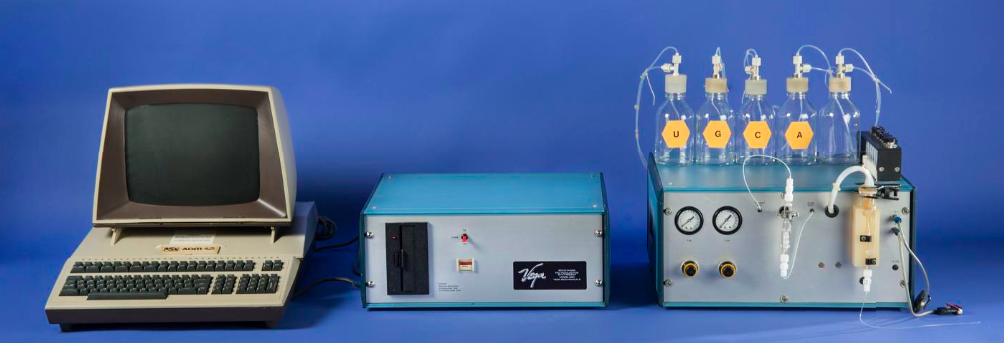
DNA synthesizer: Why the innovation never took off
Benchtop DNA writer is not a new product. In fact, in December 1980, Vega Biotechnologies introduced the first polynucleotide synthesizer "The Coder Model 280" that retailed for $49,500 (~$137,000 in today's money) and can write 15 bases in a day. A month later, a company called Bio Logicals announced a competing model that costed just under $30,000, thus began the booming era of "the gene machine". None of these machines can actually make a gene, but instead can only make oligos which were largely used for PCR. But the aspiration was there to capture everyone's imagination, including a future writer for Star Trek (see the article below from The Washington Post in 1981).
A decade later, an article from The Scientist profiled eight companies who supply DNA synthesizers. Seven out of the eight, including Vega, ended up being absorbed, dissolved, merged, or slid into obscurity over the next decade, despite having wonderful product names such as "The Gene Assembler Plus" and "The Generator".
The only "success" story from that era was Applied Biosystems, who launched the "380A DNA Synthesizer" in 1983. But a brief look at its history of their product launches suggests that after its acquisition by Perkin-Elmer in 1993, DNA synthesizers were no longer a primary focus of its product portfolio. In fact, in a 2006 publication that celebrated Applied Biosystems' 25th anniversary, DNA synthesizer launches were never mentioned after 1996 (A picture of the beautifully designed model 3900, launched in 2000 is below).
Instead, the company has refocused its efforts to DNA sequencing to capitalise on the Human Genome Project, and later on qPCR, proteomics, then SNP detection. Today, after multiple rounds of corporate restructuring, the Applied Biosystems name survives under the umbrella of Thermo Fisher Scientific.
This is not to say that DNA synthesizers are things of the past. Instead, the DNA users have largely switched from in-house production to outsourced, service-based DNA products, giving rise to companies such as IDT and GenScript.
The romantic vision of making the blueprint of lives was from the early 80s was certainly tantalizing. But the market was not ready, and the demand did not sustain. Outside forces such as the Human Genome Project quickly made DNA synthesis out of fashion.
This is a warning tale for companies that exclusively focusing on providing DNA synthesis instrument - Applied Biosystems exists today precisely because it deprioritized the DNA synthesis market; it responded swiftly to different market forces, while other companies, who should have been much more agile because of their smaller sizes, fail to react quickly.
Today, a new generation of DNA synthesis companies such as Twist Bioscience came onto the scene just a couple of years ago, reinvigorating the DNA synthesis industry.
The driving force behind this new wave of enthusiasm is the same force that drives the synthetic biology field as a whole: the Moore's Law-beating cost reduction of sequencing (see below) offers rapid access to a large amount data which enables an accelerated understanding of biology, the discovery of new therapeutic methods, and eventually engineering biology.
But is this new excitement a fad? The rise and fall of Gen9 tells us that the DNA synthesis space is very difficult to navigate, especially when it comes to sustaining the market interest. But the $250 million total funding Twist Bioscience raised suggests that venture capitalists are confident about the space. With such a large amount of capital, Twist can tailor to, or even change the consumer mentality of the 21st century.
Companies like ours, who are inspired to provide a new generation of DNA writing instruments, must tread carefully. It is refreshing to see startups like Briefcase Biotec launching a modern-looking DNA synthesizer, despite offering a similar capability to a machine launched almost 30 years ago. Maybe this time, the market is ready, or maybe, a new market force is around the corner to drive the demand out again.



Founder and Principal at GenApex Bio
4yThis article misses the forces in the market that changed the cost and market dynamics that had little to do with oligo synthesis technology directly: the ability to fax oligo orders (later email or web portal ordering) and FedEx (and the like) next day delivery services. The oligo business depends on scale for margin, distributed low throughput oligo synthesis in a lab required cost of a largely dedicated operator, maintenance and waste disposal. The ability to easily order and quickly receive oligos, generally primers, drove the early PCR market and made in lab oligo primer synthesis obsolete. The market grew, the method of order fulfillment changed.
...
5yI guess going from two weeks to nine minutes for base addition is a pretty nice improvement.
Patent Attorney, Duane Morris LLP
5yNice brief write up on the historical DNA synthesis market. I remember discussing this with John Houghland at Illumina (who was Illumina’s first retiree, or so it was announced at his retirement party there), and he recalled when it took 2 weeks to add 1 base to an oligonucleotide. He had since upgraded to working on some of Illumina’s awesome oligo synthesizers which were much faster.